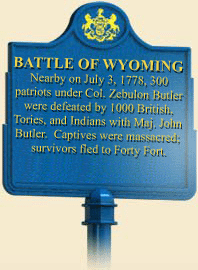Welcome to Wyoming, Pennsylvania, the site of a pivotal moment in American Revolutionary history, the 1778 Battle of Wyoming. As you explore this historic region, imagine the rolling fields and dense forests as they were more than two centuries ago when tensions between British Loyalists and American Patriots reached a boiling point.
The Wyoming Valley was originally settled by European colonists in the mid-18th century, with the fertile lands drawing families hoping to build new lives. But by 1778, the American Revolutionary War had cast a shadow over the valley. The strategic location was coveted by both British and American forces, leading to a confrontation that would forever alter the landscape and its history.
The Battle of Wyoming took place on July 3, 1778. It was a brutal conflict, part of the broader series of confrontations known as the Sullivan Expedition. The battle saw a force of roughly 300 American Patriots, largely untrained, facing off against 1,000 British Loyalists and Iroquois allies. The Patriots, under the command of Colonel Zebulon Butler, were decisively defeated, leading to the infamous Wyoming Massacre.
This tragic event resulted in the deaths of over 200 Patriots, with many settlers fleeing to escape the violence. The stories from that day are both harrowing and heroic, reflecting the tenacity of those who lived through it. The battle’s aftermath was marked by desolation, as homes were burned and survivors fled in sorrow.
Notable figures from this era include Colonel Butler, who, despite the defeat, became a symbol of resistance and resilience. Another key figure was Chief Joseph Brant, a Mohawk leader allied with the British, who played a significant role in the battle and whose legacy is remembered for his tactical prowess.
Over time, the Wyoming Valley recovered and transformed. The memory of the battle has been preserved through commemorations and monuments, such as the Wyoming Monument, erected in 1833 to honor the fallen. The site has become a symbol of American endurance and the complexities of war, drawing visitors eager to connect with this poignant chapter of history.
Today, the area stands as a testament to the enduring spirit of those who fought and the lessons learned from conflict. As you stand here, you are not just witnessing a site of historical significance but are stepping into a story that helped shape the nation. The legacy of the Battle of Wyoming reminds us of the costs of freedom and the resilience needed to secure it.






